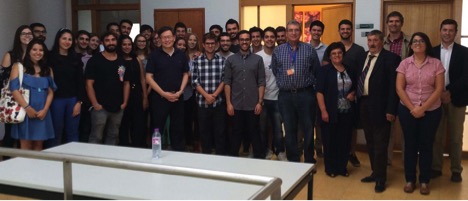José Silva, who graduated after doing a successful research project at SRON in Groningen, passed his NOVA University of Lisbon graduation exams with the best possible score for his master thesis: 20 points.During his graduation research, José Silva developed nano-bolometers (hot electron bolometer mixers) for a future far-infra-red space-camera that helps to find out what’s happening in the cooler parts of space between stars and galaxies.

The university’s examination committee rarely gives such outstanding graduation scores. José is now Master of Science in Micro and Nanotechnologies Engineering and took a job offer from SRON, following his dream of developing nanotechnology for use in space projects.
Supervised by Darren Hayton and Jian-Rong Gao, José first mastered terahertz characterization technique quickly. He then successfully tested and selected candidate detectors which are based on nano-scaled bolometer mixers and demonstrated them to work in a heterodyne array of 8 pixels. This is the key technology for terahertz cameras, needed for NASA’s next big stratospheric balloon observatory mission, called GUSTO.
José’s work is a very important result to show NASA, before they make the final camera selection after they visit the principal investigator for GUSTO, the University of Arizona in January 2017. The cameras based on nano-bolometers are the potential for future far infrared space missions. With the novel cameras, astronomers will be able to pinpoint atoms and molecules in the interstellar medium in our galaxy, and untangle complexities about these areas in space.
The hot electron bolometer mixer devices were fabricated at the Delft University of Technology.
In November, Jian-Rong Gao and Darren Hayton will travel to Antarctica, preparing the launch of STO-2. This stratospheric balloon mission precedes GUSTO.
José’s graduation talk excited other students at NOVA University of Lisbon. His fellow student Ricardo Farinha graduated the same day and was also highly appreciated by the exam committee for his thesis work, performed at TU Delft and partly at SRON-Groningen.


